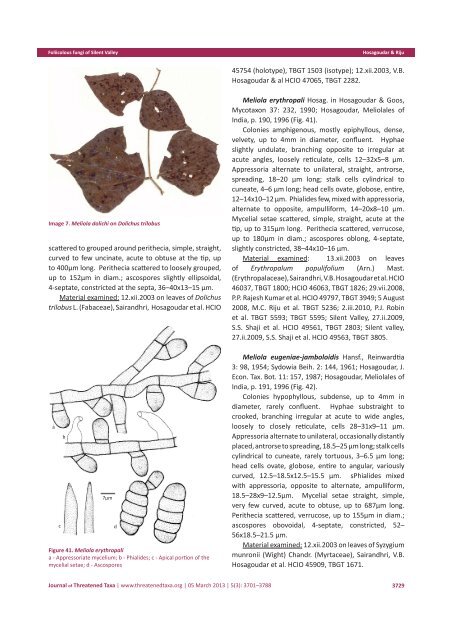Foliicolous fungi <strong>of</strong> Silent ValleyHosagoudar & Rijua8µm7µmdbbacdcFigure 38. Meliola daviesii var. longisetaa - Appressoriate mycelium; b - Phialides; c - Apical portion <strong>of</strong> themycelial setae; d - Ascosporesopposite to alternate, 16–20x8–10 µm. Mycelial setaenumerous, mostly grouped around perithecia, simple,straight, acute, up to 315µm long. Perithecia scattered,verrucose, up to 150µm in diam.; ascospores obovoidal,4-septate, constricted, 34–40x14–16 µm.Material examined: 12.xii.2003 on leaves <strong>of</strong>Nephelium sp. (Sapindaceae), Sairandhri, V.B.Hosagoudar et al. 47717, TBGT2739; Sairandhri,13.xii.2003, V.B. Hosagoudar et al. HCIO 46276, 46341,TBGT 1922, 1987.Meliola daviesii Hansf. var. longiseta Hosagoudar, J.Mycopathol. Res. 44: 44, 2006 (Fig. 38).Colonies hypophyllous, dense, velvety, up to 5mmin diameter. Hyphae substraight to flexuous, branchingirregular at acute to wide angles, loosely to closelyreticulate, cells 24–28x6–8 µm. Appressoria alternate,antrorse to retrorse, <strong>of</strong>ten spreading, straight to variouslycurved, 24–36 µm long; stalk cells cylindrical to cuneate,9–16 µm long; head cells ovate, oblong, entire, angular,rarely sublobate to lobate, 14–20x9–13 µm. Phialidesborne on a separate mycelial branch, alternate toopposite, ampulliform, 12–16x6–8 µm. Mycelial setaescattered, simple, straight to curved, acute to obtuse atthe tip, up to 850µm long. Perithecia globose, scattered,up to 130µm in diam.; ascospores oblong, 4-septate,constricted, 38–42x11–16 µm.Material examined: 13.xii.2003 on leaves <strong>of</strong> Jasminumrottlerianum Wall. ex A. DC. (Oleaceae), Sairandhri, V.B.Hosagoudar et al. HCIO 45775 (holotype), TBGT 1524(isotype).Meliola diospyricola Hansf., Proc. Linn. Soc. NewFigure 39. Meliola diospyricolaa - Appressoriate; b. Phialide; c - Apical portion <strong>of</strong> the mycelial setae,d - AscosporesSouth Wales 78: 55, 1953; Sydowia Beih. 2: 498, 1961;Hosagoudar, J. Econ. Taxon. Bot. 29: 442, 2005 (Fig. 39).Colonies hypophyllous, dense, up to 3mm indiameter, confluent. Hyphae straight, substraight tocrooked, branching opposite to irregular at acute to wideangles, loosely to closely reticulate, cells 22–35x5–7 μm.Appressoria alternate, about 2–3% opposite, antrorse,subantrorse, closely antrorse to retrorse, straight tocurved, 22–26 μm long; stalk cells cylindrical to cuneate,6–8 μm long; head cells ovate, oblong to cylindrical,entire to rarely angular, 16–18x9–11 μm. Phialides mixedwith appressoria, alternate to opposite, ampulliform,24–28x4–7 μm. Mycelial setae closely scattered, simple,straight, acute at the tip, up to 882μm long. Peritheciascattered to loosely grouped, verrucose, up to 250μm indiameter; ascospores oblong to cylindrical, 4-septate,middle cell slightly larger, constricted at the septa, 42–45x15–17 μm.Material examined: 1.vii.2008 on leaves <strong>of</strong> Diospyrossp. (Ebenaceae), Silent Valley, M.C. Riju et al. HCIO50371, TBGT 4288Meliola dolichi Hosagoudar, J. Mycopathol. Res. 44:44, 2006 (Image 7).Colonies epiphyllous, dense, up to 2mm in diameter,<strong>of</strong>ten confluent. Hyphae straight, substraight, flexuousto crooked, branching opposite to irregular at acuteto wide angles, loosely to closely reticulate, cells 16–24x5–7 µm. Appressoria alternate, unilateral, about3% opposite, straight to curved, antrorse, subantrorseto retrorse, 14–21 µm long; stalk cells cylindrical tocuneate, 4–8 µm long; head cells ovate, globose, straightto curved, <strong>of</strong>ten attenuated at the apex, entire, 9–15x11–13 µm. Phialides mixed with appressoria, alternate toopposite, ampulliform, 14–16x8–12 µm. Mycelial setae3728<strong>Journal</strong> <strong>of</strong> <strong>Threatened</strong> <strong>Taxa</strong> | www.threatenedtaxa.org | 05 March 2013 | 5(3): 3701–3788
Foliicolous fungi <strong>of</strong> Silent ValleyHosagoudar & Riju45754 (holotype), TBGT 1503 (isotype); 12.xii.2003, V.B.Hosagoudar & al HCIO 47065, TBGT 2282.Image 7. Meliola dolichi on Dolichus trilobusscattered to grouped around perithecia, simple, straight,curved to few uncinate, acute to obtuse at the tip, upto 400µm long. Perithecia scattered to loosely grouped,up to 152µm in diam.; ascospores slightly ellipsoidal,4-septate, constricted at the septa, 36–40x13–15 µm.Material examined: 12.xii.2003 on leaves <strong>of</strong> Dolichustrilobus L. (Fabaceae), Sairandhri, Hosagoudar et al. HCIOacb7µmdFigure 41. Meliola erythropalia - Appressoriate mycelium; b - Phialides; c - Apical portion <strong>of</strong> themycelial setae; d - AscosporesMeliola erythropali Hosag. in Hosagoudar & Goos,Mycotaxon 37: 232, 1990; Hosagoudar, Meliolales <strong>of</strong>India, p. 190, 1996 (Fig. 41).Colonies amphigenous, mostly epiphyllous, dense,velvety, up to 4mm in diameter, confluent. Hyphaeslightly undulate, branching opposite to irregular atacute angles, loosely reticulate, cells 12–32x5–8 µm.Appressoria alternate to unilateral, straight, antrorse,spreading, 18–20 µm long; stalk cells cylindrical tocuneate, 4–6 µm long; head cells ovate, globose, entire,12–14x10–12 µm. Phialides few, mixed with appressoria,alternate to opposite, ampulliform, 14–20x8–10 µm.Mycelial setae scattered, simple, straight, acute at thetip, up to 315µm long. Perithecia scattered, verrucose,up to 180µm in diam.; ascospores oblong, 4-septate,slightly constricted, 38–44x10–16 µm.Material examined: 13.xii.2003 on leaves<strong>of</strong> Erythropalum populifolium (Arn.) Mast.(Erythropalaceae), Sairandhri, V.B. Hosagoudar et al. HCIO46037, TBGT 1800; HCIO 46063, TBGT 1826; 29.vii.2008,P.P. Rajesh Kumar et al. HCIO 49797, TBGT 3949; 5 August2008, M.C. Riju et al. TBGT 5236; 2.iii.2010, P.J. Robinet al. TBGT 5593; TBGT 5595; Silent Valley, 27.ii.2009,S.S. Shaji et al. HCIO 49561, TBGT 2803; Silent valley,27.ii.2009, S.S. Shaji et al. HCIO 49563, TBGT 3805.Meliola eugeniae-jamboloidis Hansf., Reinwardtia3: 98, 1954; Sydowia Beih. 2: 144, 1961; Hosagoudar, J.Econ. Tax. Bot. 11: 157, 1987; Hosagoudar, Meliolales <strong>of</strong>India, p. 191, 1996 (Fig. 42).Colonies hypophyllous, subdense, up to 4mm indiameter, rarely confluent. Hyphae substraight tocrooked, branching irregular at acute to wide angles,loosely to closely reticulate, cells 28–31x9–11 µm.Appressoria alternate to unilateral, occasionally distantlyplaced, antrorse to spreading, 18.5–25 µm long; stalk cellscylindrical to cuneate, rarely tortuous, 3–6.5 µm long;head cells ovate, globose, entire to angular, variouslycurved, 12.5–18.5x12.5–15.5 µm. sPhialides mixedwith appressoria, opposite to alternate, ampulliform,18.5–28x9–12.5µm. Mycelial setae straight, simple,very few curved, acute to obtuse, up to 687µm long.Perithecia scattered, verrucose, up to 155µm in diam.;ascospores obovoidal, 4-septate, constricted, 52–56x18.5–21.5 µm.Material examined: 12.xii.2003 on leaves <strong>of</strong> Syzygiummunronii (Wight) Chandr. (Myrtaceae), Sairandhri, V.B.Hosagoudar et al. HCIO 45909, TBGT 1671.<strong>Journal</strong> <strong>of</strong> <strong>Threatened</strong> <strong>Taxa</strong> | www.threatenedtaxa.org | 05 March 2013 | 5(3): 3701–37883729

















